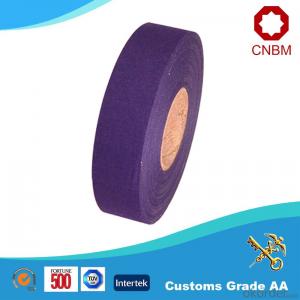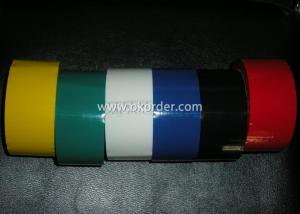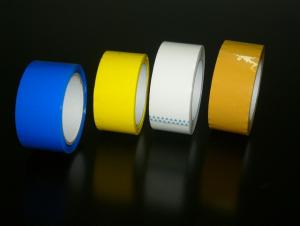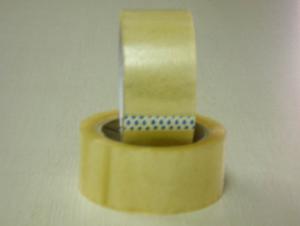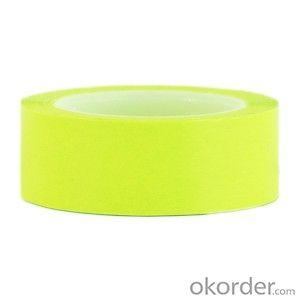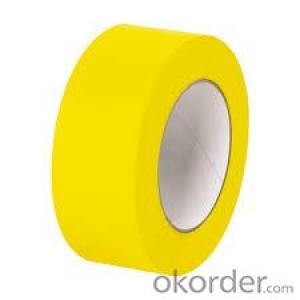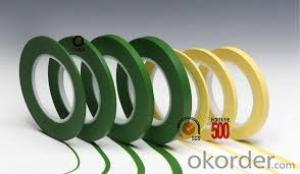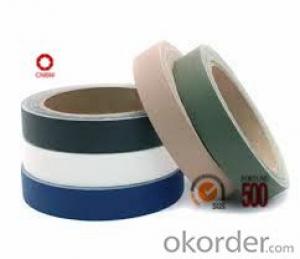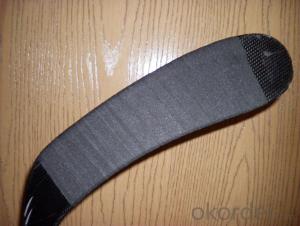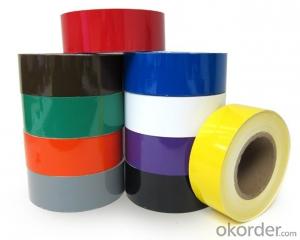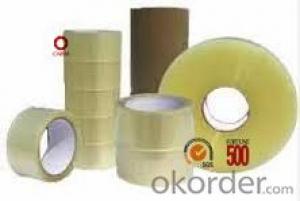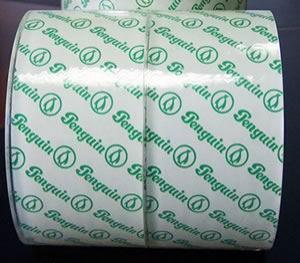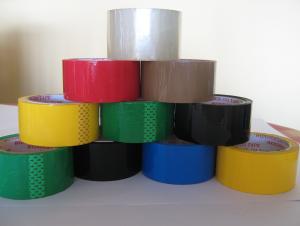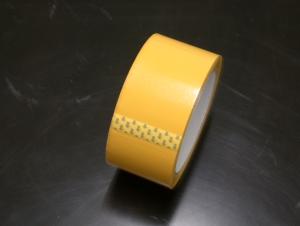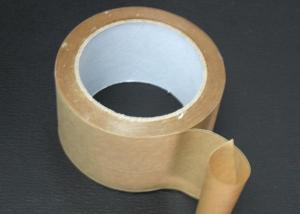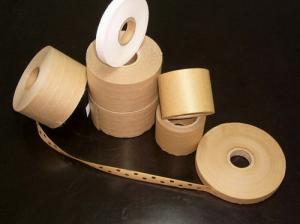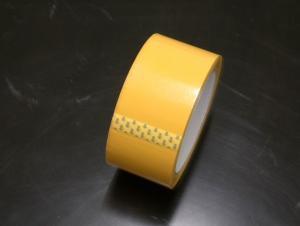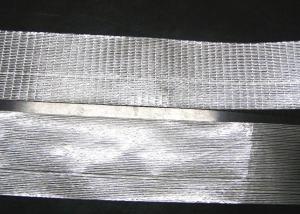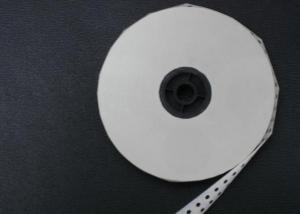Wholesale BOPP Packaging Tape for Ice Hockey Cloth Tape Wrapping - China Producer
- Loading Port:
- Shanghai
- Payment Terms:
- TT OR LC
- Min Order Qty:
- 10 roll
- Supply Capability:
- 3000000 roll/month
OKorder Service Pledge
OKorder Financial Service
You Might Also Like
Specification
Cloth Tape for Ice Hockey Wrapping China Producer
Product Description
Cloth Hockey Tape is 100%cotton, The tape is flexible,strong ahesive,not easy wrinkle, suitbale for protection from sports;gif.
Specifications:
100% Cotton Ice Hockey Tape
50% Cotton with 50% Polyester Hockey Tape
Pure PVC Hockey Tape
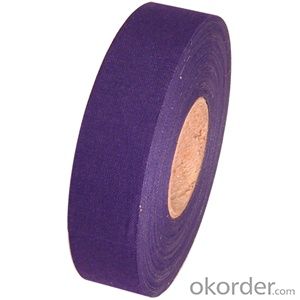

Data Sheet
Item | Hockey Tape |
Carrier | 100% Polyester Cloth |
Adhesive | Hot melt/Rubber Adhesive |
Producing Place | China |
Color | Various Colors |
Tensile Strength | ≥180 N/cm |
Certification | SGS and ISO9001 |
Packing | Hockey Tape in Carton |
Delivery | Within 15 Days |
Payment | TT & LC |
Exhibition Domestic and Oversea

Company
As World Top 500 companies, China National Building Materials Group has clients from over 160 countries and wholly-owned overseas subsidiaries and branches in 10 countries.
FAQ
1. What is our strength?
20 Years Experience USD1.6 billion yearly sales
World Top 500 Enterprise
Custom-made advices for your need
2. What is your products features?
Anti-slip
Excellent tensile strength ,easy tear ,water resistant,self-adhesive
Easy-tear by hand
Leave no residue to skin
Strong adhesive
3. Delivery time
10 days after receiving the deposit
4. Where do you export?
USA, Russia, Canad and other countries
5. What is other adhesive tapes?
Cloth Tape and PVC Tape
- Q: What is the difference between acrylic and hot melt adhesive for packaging tape?
- Packaging tape commonly utilizes two types of adhesives: acrylic and hot melt. These adhesives possess distinct characteristics that set them apart. A significant disparity lies in their bonding strength. Hot melt adhesive boasts exceptional bonding strength, making it ideal for heavy-duty applications. It creates a robust and durable bond that can withstand rigorous handling and varying temperatures. Conversely, acrylic adhesive typically offers a lower level of bonding strength in comparison. While still suitable for most general packaging requirements, it may not be the best choice for heavy or bulky items. Another distinction can be found in the application process. Hot melt adhesive is applied in a molten state and solidifies once cooled. Typically, it is dispensed using a hot melt glue gun or applicator. The quick setting time of hot melt adhesive allows for swift packaging operations, making it popular in high-volume settings. On the other hand, acrylic adhesive is applied in a liquid form and requires some time to cure and establish a strong bond. It can be applied using a hand dispenser or tape gun, and optimal adhesion often necessitates some pressure. Moreover, hot melt adhesive demonstrates excellent adhesion to a wide array of surfaces, including cardboard, plastics, and metals. Its versatility allows for usage with various packaging materials. While acrylic adhesive also adheres well to different surfaces, it may not exhibit the same level of compatibility with certain low-energy surfaces, such as polyethylene or polypropylene. Furthermore, temperature resistance is an essential factor to consider. Hot melt adhesive performs admirably in both high and low temperatures, maintaining its bonding strength. It can endure freezing temperatures and heat without compromising its adhesive properties. Acrylic adhesive, while generally offering good temperature resistance, may not be as effective in extreme conditions, particularly at very high or low temperatures. In conclusion, the primary disparities between acrylic and hot melt adhesives for packaging tape lie in bonding strength, the application process, surface compatibility, and temperature resistance. While hot melt adhesive provides superior bonding strength, rapid setting time, and excellent temperature resistance, acrylic adhesive offers versatility, ease of application, and good adhesion to most surfaces. The choice between the two depends on specific packaging needs, materials used, and environmental conditions.
- Q: Is packaging tape resistant to tearing or ripping?
- Yes, packaging tape is designed to be resistant to tearing or ripping. It is typically made from strong materials like polypropylene or polyester and has reinforced fibers or adhesive for added durability.
- Q: Does packaging tape come in different thicknesses for added durability?
- Yes, packaging tape does come in different thicknesses for added durability. Thicker tapes are often preferred for heavier or more secure packaging needs, as they provide increased strength and resistance to tearing or breaking.
- Q: How does packaging tape perform on high-friction surfaces?
- Packaging tape is designed to adhere to a wide variety of surfaces, including high-friction surfaces. Its performance on high-friction surfaces can vary depending on the specific tape and the nature of the surface. In general, packaging tape is equipped with strong adhesive properties that allow it to stick securely to surfaces, even those with high friction. The adhesive on the tape is formulated to provide excellent tackiness and bonding strength, ensuring that it stays in place and maintains its hold on high-friction surfaces. However, it is important to note that excessive friction or roughness on a surface can potentially affect the tape's adhesion. If the surface is extremely rough or uneven, it may create air pockets or gaps between the tape and the surface, which can compromise its performance. In such cases, it is advisable to prepare the surface properly by cleaning and smoothing it before applying the tape to ensure optimal adhesion. Additionally, the durability of the tape can play a role in its performance on high-friction surfaces. Some packaging tapes are reinforced with fibers or have a thicker construction, making them more resistant to wear and tear caused by friction. These tapes are often recommended for heavy-duty applications or when packaging items that will be subjected to constant rubbing or sliding on high-friction surfaces. Overall, packaging tape is generally well-suited for use on high-friction surfaces. Its adhesive properties, combined with proper surface preparation and selection of a suitable tape, can ensure reliable and long-lasting adhesion, even in challenging conditions.
- Q: What are the advantages of using packaging tape over other sealing methods?
- There are several advantages of using packaging tape over other sealing methods. Firstly, packaging tape provides a strong and secure seal that can withstand the rigors of shipping and handling. It is designed to adhere to various surfaces, including cardboard, plastic, and metal, ensuring that the package remains intact throughout its journey. Secondly, packaging tape is easy to use and can be quickly applied to seal a package. Unlike other sealing methods such as glue or staples, tape does not require any additional tools or equipment. This saves time and allows for efficient packaging processes. Furthermore, packaging tape offers versatility in terms of size and strength. It is available in different widths and thicknesses, allowing for customization based on the specific needs of the package. Whether you are sealing a small envelope or a large box, there is a packaging tape option that suits your requirements. Another advantage of packaging tape is its cost-effectiveness. Compared to other sealing methods, tape is generally more affordable. It offers a cost-efficient solution for businesses and individuals who frequently ship or package items. In addition, packaging tape is tamper-evident, providing an added layer of security. Once the tape is applied, any attempt to tamper with the package will be evident due to the broken or damaged tape seal. This helps to deter theft and provides peace of mind to both the sender and recipient. Lastly, packaging tape is easily removable. It can be peeled off without leaving any residue or damaging the packaging materials. This is particularly important for packages that may require resealing or for recipients who may want to reuse the packaging. Overall, the advantages of using packaging tape over other sealing methods include its strength, ease of use, versatility, cost-effectiveness, tamper-evident properties, and ease of removal. These benefits make packaging tape a reliable and efficient choice for sealing packages.
- Q: Does packaging tape come in different allergen-free options?
- Indeed, various allergen-free alternatives exist for packaging tape. Numerous manufacturers provide packaging tape that is explicitly formulated to be hypoallergenic, devoid of typical allergens like latex, gluten, and other potential irritants. These options without allergens prove especially advantageous for individuals with sensitive skin or allergies. It is highly advisable to thoroughly peruse the product labels or descriptions to guarantee that the packaging tape aligns with your precise allergen-free needs.
- Q: Buy adhesive tape every time, discover its sticky viscosity is insufficient, encounter cold weather, do not use well,
- Adhesive tape testing methods are mainly1, tack: the test tape is stuck to the initial ability of the adherend size, general method is to use the standard ball into the natural roll tape 45 degree angle on the tilt, increasing the size of the ball, the ball can stick to the greater, the greater initial viscosity
- Q: Does packaging tape have an expiration date?
- Packaging tape typically does not have an expiration date. This is because packaging tape is usually made from durable materials such as polypropylene or PVC, which have a long shelf life and do not degrade easily over time. As long as the tape is stored in a cool, dry place, away from direct sunlight and extreme temperatures, it should remain effective for a long period. However, it is important to note that the adhesive on packaging tape may lose its stickiness over time, especially if it is exposed to heat or moisture. So, while packaging tape may not have an official expiration date, it is advisable to use it within a reasonable timeframe to ensure its adhesive properties are still intact.
- Q: Can packaging tape be used for sealing construction materials or tools?
- Yes, packaging tape can be used for sealing construction materials or tools. Packaging tape is designed to securely seal boxes and packages, so it can also be used to seal construction materials or tools. It provides a strong and durable bond, making it suitable for sealing various types of materials such as wood, metal, plastic, or concrete. However, it is important to consider the weight and the nature of the materials being sealed. For heavier or more demanding construction applications, it may be more appropriate to use specialized tapes or adhesives specifically designed for construction purposes.
- Q: Can packaging tape be used for sealing household or kitchen items?
- Yes, packaging tape can be used for sealing household or kitchen items. It provides a strong and secure seal, making it suitable for sealing boxes, containers, and various kitchen items like food storage bags or jars. However, it is important to ensure that the tape is food safe and does not come into direct contact with consumable items.
Send your message to us
Wholesale BOPP Packaging Tape for Ice Hockey Cloth Tape Wrapping - China Producer
- Loading Port:
- Shanghai
- Payment Terms:
- TT OR LC
- Min Order Qty:
- 10 roll
- Supply Capability:
- 3000000 roll/month
OKorder Service Pledge
OKorder Financial Service
Similar products
Hot products
Hot Searches
Related keywords
